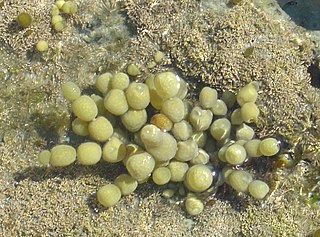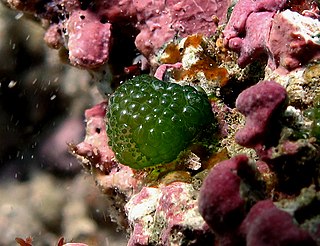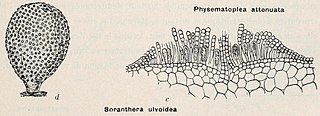
Hormosira banksii, also known as Neptune's necklace, Neptune's pearls, sea grapes, or bubbleweed) is a species of seaweed native to Australia and New Zealand. The genus Hormosira is monotypic.

Coralline algae are red algae in the order Corallinales. They are characterized by a thallus that is hard because of calcareous deposits contained within the cell walls. The colors of these algae are most typically pink, or some other shade of red, but some species can be purple, yellow, blue, white, or gray-green. Coralline algae play an important role in the ecology of coral reefs. Sea urchins, parrot fish, and limpets and chitons feed on coralline algae. In the temperate Mediterranean Sea, coralline algae are the main builders of a typical algal reef, the Coralligène ("coralligenous"). Many are typically encrusting and rock-like, found in marine waters all over the world. Only one species lives in freshwater. Unattached specimens may form relatively smooth compact balls to warty or fruticose thalli.

Turbinaria ornata is a tropical brown algae of the order Fucales native to coral reef ecosystems of the South Pacific. Turbinaria ornata is more commonly referred to as crowded sea bells in the US and crowned sea bells worldwide. It can quickly colonize these ecosystems due in part to its method of dispersing by detaching older and more buoyant fronds that travel on surface currents, sometimes in large rafts of many individual thalli, or fronds. Some scientists are investigating whether the increase in density of seaweeds, and a decrease in living coral density, on coral reef ecosystems indicates a change in the health of the reef, focusing studies on this particular species of brown alga.

Colpomenia peregrina, sometimes referred to by its vernacular names oyster thief and bladder weed, is a species of brown seaweed.

Colpomenia is a genus of brown macroalgae in the family Scytosiphonaceae.

Nematothallus is a form genus comprising cuticle-like fossils. Some of its constituents likely represent red algae, whereas others resemble lichens.

Dictyosphaeria is a genus of green algae in the family Siphonocladaceae.

Hydroclathrus is a genus of perforate brown alga, of the phylum Ochrophyta and the class Phaeophyceae.
Lobophora variegata is a species of small thalloid brown alga which grows intertidally or in shallow water in tropical and warm temperate seas. It has three basic forms, being sometimes ruffled, sometimes reclining and sometimes encrusting, and each form is typically found in a different habitat. This seaweed occurs worldwide. It is the type species of the genus Lobophora, the type locality being the Antilles in the West Indies.
Mary Johnston(e) Lynn was an Irish botanist known for her phyto-ecological studies in Northern Ireland.

Soranthera ulvoidea, sometimes called the studded sea balloon, is a species of brown algae in the family Chordariaceae. It is the only species in the monotypic genus Soranthera. The generic name Soranthera is from the Greek soros (heap) and antheros (blooming). The specific epithet ulvoidea refers to certain resemblances the algae has with Ulva. The name in Japanese is 千島袋のり / ちしまふろくのり literally meaning "Kuril Islands bag nori".
Chondria tumulosa is a species of red algae in the family Rhodomelacae. It was first discovered in 2016, growing in small patches in the Pearl and Hermes Atoll in the Northwestern Hawaiian Islands. By 2019, the species had spread to cover several thousand square meters, smothering and killing vast swathes of the atoll's coral reefs. C. tumulosa is unlike any other species in its genus, having a tumbleweed-like growth form that allows fragments to break off and spread, allowing it to colonize new areas. The true origin of C. tumulosa in the region remains unknown; it displays many characteristics of an invasive species and is not closely related to any other Hawaiian Chondria, but it would have been relatively difficult to colonize such a remote area. It has also been suggested that it is a native species that suddenly spread due to changes in the ecosystem. Control and mitigation strategies will have to be made to prevent the species' spread.

Lilian Lyle was a British teacher, botanist, and phycologist who collected and published on a number of algae species during the 1920s. Lyle was elected a Fellow of the Linnean Society of London on 17 June 1915.
Codium edule is a green alga common on shallow reef flats from the intertidal to the subtidal in tropical waters of the Indo-Pacific. The species is common in Hawaiʻi where it is usually called wāwaeʻiole and considered an edible alga or limu. Prominent ethnobotanist, Isabella Abbott, described its usage in her writing.
Formerly known as Sargassum echinocarpum, Sargassum aquifolium is an abundant brown algae of the order Fucales, class Phaeophyceae, genus Sargassum. In Hawaii, it is commonly known as limu kala. This alga is endemic to Hawaiʻi, one out of the four endemic species of endemic Sargassum.
Padina sanctae-crucis is a species of brown macroalgae in the family Dictyotaceae. It is a tropical brown algae species native to the south pacific that belongs to the Padina genus. this alga includes sexual reproduction and spore-producing asexual reproduction which is moved with the tide until spores plants itself on a hard rocky substrate. Other habitats include rocks and shell fragments in the shallow sublittoral, seagrass meadows, mangrove roots and coral reefs on tidal flats.

Dictyosphaeria cavernosa is a species of green algae in the family Siphonocladaceae, one of the three species in this family. Its common name is green bubble seaweed.
Halimeda discoidea is a species of calcareous green algae in the order Bryopsidales. It is commonly known as Money Plant due to its appearance and is usually found in the tropics.
A mycophycobiosis (composed of myco-, from the Ancient Greek: μύκης, phyco-, from Ancient Greek: φῦκος,, and -biose, from ancient Greek: βιόω is a symbiotic organism made up of a multicellular algae and an ascomycete fungus housed inside the algae. The algae and fungus involved in this association are called mycophycobionts.










